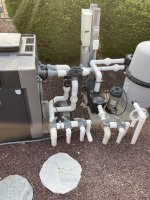- May 18, 2015
- 356
- Pool Size
- 28000
- Surface
- Plaster
- Chlorine
- Salt Water Generator
- SWG Type
- CircuPool RJ-60 Plus
So after reading several posts here, I think it is a wise decision to go with a SWG unit. It’s just too hard to keep my chlorine level stable especially when we take vacations and there is nobody here to add the liquid.
So, I like the Circupool brand for their reliability and warranty.
I have a 28,000 gallon pool, it sees light to moderate use. I typically open early and close on time or a tad late because of the attached spa. The heater extends the season. So it’s open late April through September. About 5 months.
I looked at a chart on a vendors website inputting my pool size and location. It recommends the RJ45 plus or the Core 55 unit. Do these sound right for my pool size and geographic location?
I also intend on installing a new Hayward VSP. I purchased the W3SP2603VSP but have not installed it yet.
My only issue is where to install the SWG unit. I may need some plumbing modifications as there is no large section of straight plumbing after the heater to put it.
Thoughts on either of those 2 SWG units? Possible another unit to suggest and where to install? Here is my equipment pad ..
So, I like the Circupool brand for their reliability and warranty.
I have a 28,000 gallon pool, it sees light to moderate use. I typically open early and close on time or a tad late because of the attached spa. The heater extends the season. So it’s open late April through September. About 5 months.
I looked at a chart on a vendors website inputting my pool size and location. It recommends the RJ45 plus or the Core 55 unit. Do these sound right for my pool size and geographic location?
I also intend on installing a new Hayward VSP. I purchased the W3SP2603VSP but have not installed it yet.
My only issue is where to install the SWG unit. I may need some plumbing modifications as there is no large section of straight plumbing after the heater to put it.
Thoughts on either of those 2 SWG units? Possible another unit to suggest and where to install? Here is my equipment pad ..




